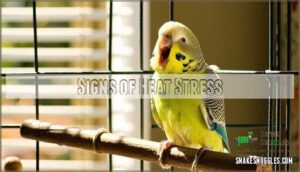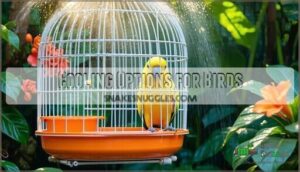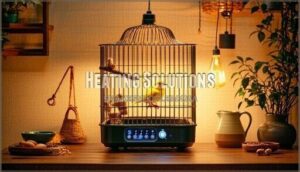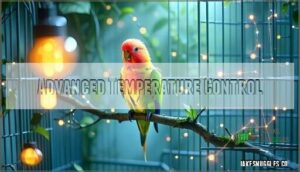This site is supported by our readers. We may earn a commission, at no cost to you, if you purchase through links.

You’ll want to watch for signs like panting, lethargy, or fluffed feathers that signal temperature stress. Position cages away from drafts, direct sunlight, and heating vents.
Use ceramic heat emitters for gentle warming and guarantee proper ventilation without creating cold spots. A simple thermometer near your bird’s favorite perch tells you everything you need to know.
Smart monitoring systems can take the guesswork out of maintaining that perfect climate zone.
Table Of Contents
- Key Takeaways
- Cage Temperature Basics
- Heat Stress Prevention
- Cold Stress Management
- Advanced Temperature Control
- Environmental Monitoring
- Frequently Asked Questions (FAQs)
- How do you heat a cage?
- Can a microcontroller monitor the temperature of a chicken cage?
- How do you measure temperature in a cage?
- Should I have multiple thermometers on my reptile cage?
- Should I use a rheostat if my cage is too hot?
- Do lizards need heat in a reptile cage?
- What are the OSHA guidelines for temperature control?
- How to regulate temperature in a terrarium?
- How do you control your core temperature?
- How to make a homemade Temperature Controller?
- Conclusion
Key Takeaways
- Monitor temperature constantly – keep your bird’s environment between 65-80°F and watch for stress signs like panting, fluffed feathers, or lethargy that signal dangerous temperature changes
- Position cages strategically – place them away from drafts, direct sunlight, and heating vents to prevent temperature fluctuations that can harm your bird’s health
- Use proper heating equipment – ceramic heat emitters provide gentle, consistent warmth while thermometers near perches give you accurate readings of your bird’s actual environment
- Invest in smart monitoring systems – automated temperature controls with alerts take the guesswork out of maintaining ideal conditions and can prevent life-threatening temperature emergencies
Cage Temperature Basics
Your bird’s body temperature runs between 104°F and 109°F, making proper cage temperature control essential for their health and survival.
Understanding temperature basics helps you create a safe environment that prevents dangerous heat stress or cold-related health issues.
Bird Temperature Sensitivity
Your bird’s thermoregulation system works differently than yours.
Unlike mammals, birds rely on avian thermoregulation and feather insulation to maintain their higher metabolic rate.
Their body temperature ranges from 104-109°F, making proper cage temperature control essential.
Each species’ habitat adaptation determines their climate impact tolerance, so understanding your bird’s natural environment guides effective temperature regulation for superior bird health.
Optimal Temperature Ranges
Most birds thrive within a recommended temperature range of 68-75°F (20-24°C), though species preferences vary substantially.
Tropical birds require warmer conditions, while temperate species tolerate cooler ranges.
Proper cage placement away from drafts and direct sunlight helps maintain ideal temperature stability. During acclimation periods, monitor your bird closely as sudden temperature changes can cause serious health impacts requiring immediate attention.
Similarly, reptile owners must consider the importance of thermal gradients for their snake’s well-being, and must be aware of the potential for serious health impacts, which can be mitigated by maintaining proper thermal conditions and being mindful of health impacts.
Species-Specific Needs
Since different species evolved in vastly different environments, you’ll need to match your bird’s temperature preferences to their natural habitats.
Tropical parrots thrive in warmer ranges of 75-82°F, while temperate zones suit canaries at 65-75°F.
Desert species require temperature fluctuations mimicking their homeland.
Proper habitat replication during the acclimation period guarantees your feathered friend’s comfort and health.
Heat Stress Prevention
Heat stress poses serious risks to your bird’s health, causing rapid breathing, panting, and potential dehydration.
You’ll need to implement effective cooling strategies and proper ventilation to create a safe environment that prevents overheating, using effective methods to ensure your bird’s well-being.
Signs of Heat Stress
Watch for rapid breathing with an open beak—your bird’s way of saying "I’m overheating!"
Panting and lethargy often appear together as early warning signs.
You’ll notice feather changes like flattening against the body, plus breathing problems including tail bobbing.
Dehydration risks increase quickly, while behavioral changes include restlessness or unusual aggression during temperature fluctuations, which can be a sign of the bird saying "I’m overheating".
Cooling Options for Birds
When temperatures soar, you’ll need effective cooling strategies to protect your feathered friends.
Smart bird cage temperature management prevents heat-related health issues through multiple approaches.
Here are five essential cooling options for birds:
- Bathing Dishes – Provide shallow water containers for natural cooling through contact and evaporation
- Misting Techniques – Use fine spray bottles to lower surrounding air temperature by 5-10°C
- Shade Provision – Position cages away from direct sunlight, reducing heat exposure by 60%
- Electrolyte Supplements – Offer specialized solutions during hot periods to maintain proper hydration balance
- Air Circulation – Install cage-mounted fans with safety guards to increase convective airflow effectively
These temperature control methods work together to maintain ideal humidity levels and prevent overheating in your bird’s environment.
Maintaining proper humidity also prevents incomplete shedding issues common in reptiles.
Ventilation Strategies
Proper airflow management keeps your feathered friends comfortable and healthy.
Position fans to create gentle cross-ventilation without direct drafts on cages.
Choose cage materials with adequate spacing for air circulation while maintaining security.
Install appropriate filter types to remove airborne particles and odors.
Strategic fan placement promotes consistent airflow patterns throughout the room.
Monitor humidity control systems to prevent moisture buildup that compromises air quality and bird health, ensuring a healthy environment through proper airflow management.
Cold Stress Management
When temperatures drop, your bird’s well-being depends on recognizing cold stress early and taking swift action.
Cold stress weakens their immune system and can lead to serious respiratory problems if left unchecked.
Cold Stress Signs
Cold birds don’t hide their discomfort well.
Your bird’s distress signals are crystal clear when temperatures drop too low.
You’ll notice these telltale signs when cage temperature control fails and temperature fluctuations create stress.
Watch for these cold stress indicators that signal immediate action:
- Shivering Symptoms – visible trembling or muscle contractions
- Feather Fluffing – birds puff up to trap warm air
- Hunched Posture – shoulders pulled up, head tucked down
- Respiratory Issues – labored breathing from weakened immunity
Lethargy often accompanies these bird behavior changes.
Birds experiencing respiratory distress may also exhibit wheezing and gasping.
Insulation Methods
Effective cage insulation starts with selecting appropriate cage material like acrylic or thick plastic panels that naturally retain heat.
Layering techniques work best when you combine multiple insulation methods rather than relying on single solutions.
| Insulation Method | Best Application |
|---|---|
| Thermal barriers | Cage bottom and sides |
| Reflective insulation | Roof and back panels |
| Draft protection strips | Door gaps and vents |
| Cage covers | Nighttime temperature control |
| Windbreaks | Outdoor cage placement |
Smart cage temperature control means understanding that reflective insulation bounces heat back toward your birds while thermal barriers prevent heat loss through cage walls.
These energy-efficient heating supplements create comfortable microclimates without dramatically increasing utility costs.
Heating Solutions
Warmth becomes your bird’s lifeline when temperatures drop below comfort levels.
Under-cage heat mats provide gentle, distributed warmth without disturbing sleep cycles. Ceramic heaters and radiant heaters offer consistent temperature regulation with thermostat control for precise adjustments.
Heat lamps deliver targeted warming zones, while heated perches create cozy spots for roosting. Consider safe heat mats for your bird’s cage.
Always use temperature control devices with automatic shutoffs to prevent overheating and guarantee your feathered friend stays safe with consistent temperature regulation.
Advanced Temperature Control
Modern technology takes the guesswork out of maintaining perfect cage temperatures for your birds.
You can now rely on automated systems, sensor networks, and infrared thermal imaging to create consistently comfortable environments that respond to your birds’ needs in real-time, utilizing infrared thermal imaging.
Automated Systems
Modern automated systems transform temperature control from guesswork into precision science.
Programmable logic controllers and IoT integration deliver real-time adjustments within ±1°C accuracy, boosting energy efficiency by 15-20%.
Remote monitoring through smart platforms enables predictive maintenance while system integration coordinates heating, cooling, and ventilation automatically.
These climate control solutions reduce heat-related mortality by over 40%.
Consider bird thermostat options for ideal pet care.
Sensor Networks
Smart sensor networks transform your cage temperature monitoring into a precision operation.
These wireless sensors deliver real-time data analysis, enabling predictive maintenance before problems strike your birds. Consider wireless monitoring solutions for efficient tracking.
- Temperature alerts notify you instantly when conditions drift outside safe ranges
- Digital thermometers with network connectivity provide continuous temperature tracking across multiple cages
- Smart monitoring systems analyze patterns to predict equipment failures before they happen
- Network security protocols protect your temperature data from unauthorized access while maintaining sensor accuracy
Infrared Thermal Imaging
Infrared thermal imaging transforms temperature monitoring by capturing heat patterns across your entire cage setup.
This non-invasive monitoring technology spots temperature fluctuations instantly, enabling stress detection and early intervention before problems escalate.
Proper imaging calibration guarantees accuracy within 0.05°C, while predictive analysis helps maintain ideal temperature regulation.
Your infrared thermometers provide thorough temperature control insights that traditional point sensors can’t match, offering infrared thermal imaging as a superior solution.
Environmental Monitoring
You’ll need accurate monitoring tools and consistent maintenance to prevent temperature-related health problems in your birds.
Proper environmental tracking guarantees your feathered friends stay comfortable year-round while catching potential issues before they become serious problems, which is crucial for their overall health.
Humidity Level Insights
Humidity-climate balance plays a vital role in your bird’s well-being, with ideal humidity ranging between 50-60% for most species.
Tropical birds require higher humidity levels than temperate species, making species humidity requirements essential knowledge.
Poor humidity control creates serious health implications, including respiratory issues and feather problems.
Monitor your cage environment regularly, as ventilation impact directly affects humidity monitoring accuracy and your bird’s comfort.
Temperature Monitoring Tools
Digital thermometers provide accurate readings within recommended ranges of 68-75°F for most bird species.
Infrared imaging detects temperature variations without disturbing your birds, while sensor calibration guarantees precision.
Automated alerts notify you of dangerous fluctuations, and data logging tracks patterns over time.
Remote probes monitor multiple cage zones simultaneously, giving you complete temperature monitoring control for ideal bird health.
Maintenance Strategies
Regular system servicing prevents equipment failures that could harm your birds. You can’t afford temperature fluctuations when your pet’s life depends on consistent monitoring.
Employee training helps everyone know proper temperature management protocols, while routine maintenance extends equipment longevity in demanding pet environments. Reptiles, unlike birds, also require specific environmental conditions, so understanding reptile habitat maintenance is vital for their well-being.
- Schedule quarterly HVAC inspections to catch problems before they affect cage temperature control
- Train all caregivers on temperature monitoring equipment operation and emergency procedures
- Keep backup heating/cooling devices ready for immediate deployment during system failures
- Document temperature logs daily to identify patterns and potential equipment issues early
- Replace air filters monthly to maintain ideal airflow and temperature stability throughout facilities
Frequently Asked Questions (FAQs)
How do you heat a cage?
Laboratory mice experience up to 30% higher mortality rates when cage temperatures exceed 28°C.
You’ll need heating pads, ceramic heat emitters, or infrared lamps for consistent warmth.
Position heat sources safely outside the cage to prevent burns while maintaining your pet’s ideal temperature range.
Can a microcontroller monitor the temperature of a chicken cage?
Yes, you can easily use a microcontroller to monitor your chicken cage temperature.
Arduino or Raspberry Pi boards with temperature sensors provide real-time monitoring, automated alerts, and data logging for ideal poultry health.
How do you measure temperature in a cage?
Like watching a fever run wild, monitoring your cage’s temperature requires precision tools placed strategically throughout the enclosure for accurate readings and ideal bird health.
Should I have multiple thermometers on my reptile cage?
Multiple thermometers are essential for your reptile’s health.
Place one at the basking spot, another at the cool end, and consider adding a digital hygrometer combo unit.
This setup helps you monitor temperature gradients accurately and guarantees your reptile can thermoregulate properly throughout the enclosure.
Should I use a rheostat if my cage is too hot?
Rheostats can work temporarily, but they’re outdated technology that creates hot spots and fire risks. You’d be better off upgrading to a reliable thermostat controller that’ll maintain consistent temperatures safely.
Do lizards need heat in a reptile cage?
Cold-blooded lizards can’t regulate their body temperature internally, so they absolutely need external heat sources.
You’ll want to provide a temperature gradient with basking spots reaching 85-95°F depending on your species’ requirements, which includes having basking spots.
What are the OSHA guidelines for temperature control?
You’ll maintain OSHA’s stance: they recommend 68-76°F for indoor workplaces but don’t mandate specific temperatures since comfort varies by individual and working conditions.
How to regulate temperature in a terrarium?
Temperature fluctuations exceeding 2°C can increase animal mortality by 30%. You’ll want to use digital thermometers, heating pads, and proper ventilation to maintain stable conditions between your species’ ideal range.
How do you control your core temperature?
Your body controls core temperature through sweating, shivering, and blood vessel changes. You can help by staying hydrated, dressing appropriately, seeking shade when hot, and warming up when cold.
How to make a homemade Temperature Controller?
Like a thermostat keeping your house comfortable, you’ll wire a temperature sensor to a microcontroller that switches heating/cooling devices on and off based on your target temperature settings.
Conclusion
Like a lighthouse guiding ships through treacherous waters, effective cage temperature control serves as your bird’s beacon of safety in an unpredictable climate.
Your feathered companion depends entirely on your vigilance to maintain their delicate thermal balance.
Mastering cage temperature control means understanding your bird’s signals, investing in reliable monitoring equipment, and responding quickly to environmental changes.
With consistent attention to these fundamentals, you’ll create a stable sanctuary that supports your bird’s health, behavior, and longevity throughout every season, ensuring their overall well-being is protected by effective care.














